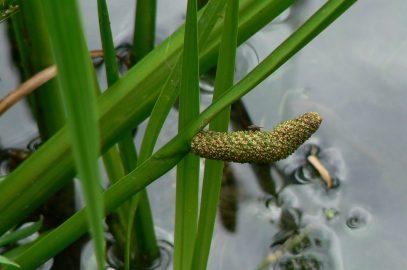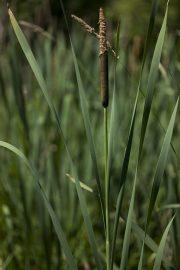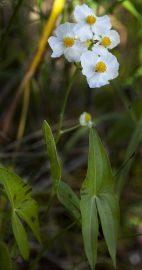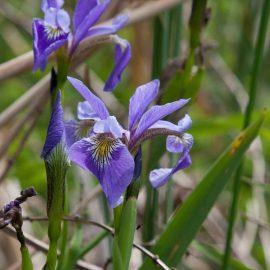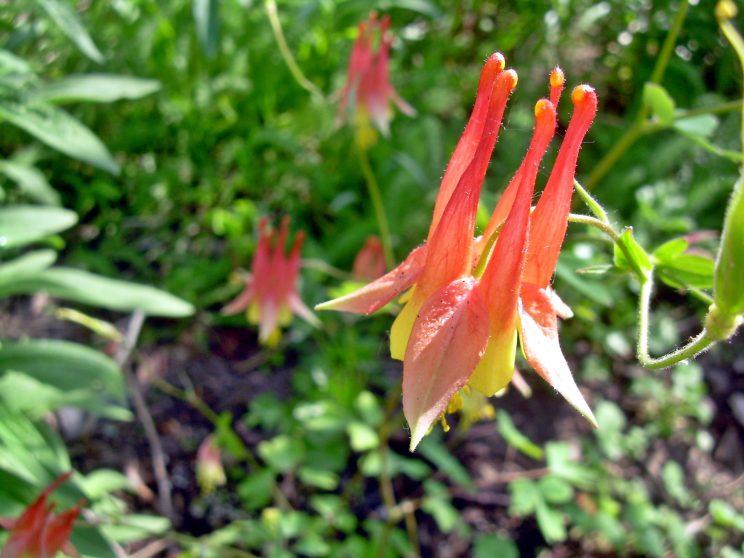by Andrew Dean
Macrophytes are plants that grow in or near water. They may be emergent (growing out of the water), submergent (growing under the water), or floating. Along the shallow edges of ponds and lakes, macrophytes provide cover for fish and habitat for aquatic invertebrates and other wildlife. They also produce oxygen and act as food for some fish and wildlife.
Sweetflag (Acorus calamus)
Perhaps the most significant wetland plant at Grenadier Pond is the perennial sweetflag, also known commonly as calamus, and a member of the arum family. Being an emergent plant, it grows in water with leaves and stems extending out of the water. It gets its name from the sweet-smelling citrusy leaves once bruised or crushed, and even stronger scented rhizomes. Rhizomes are similar to roots and form underground stems producing roots and shoots.
Sweetflag is typically found in marshes, swamps, shallow open water wetlands, along streams and generally speaking in quiet waters. Muskrats frequently consume its rootstocks and wood ducks consume its seeds.
Leaves are sword-shaped, 30-120 cm (10-50”) long with very small 3-4 mm (1/8”) greenish-yellow flowers appearing in spring and summer. Leaf margins have curled or undulating edges.
The very small flowers appear in a cylindrical spadix that extends from the side of a long leaf-like flowering stem called a spathe. A spadix is the botanical term for a type of inflorescence (i.e. a group of flowers on a stem) arranged in a spike formation, with very small flowers growing densely together. The spadix is partially covered on the flowering stem by a curved leaf-like bract resembling a hood. The spadix grows between 5 and 9 cm (2-4”) during flowering. (Other native Ontario plants with a spadix floral head include wild calla (Calla palustris) and Jack-in-the-pulpit (Arisaema triphyllum).)
Sweetflag is actually infertile and does not produce viable seed; it relies on vegetative reproduction through its rhizomes, thereby forming groves.
NOTE: All sweetflag in North American has long been lumped together as Acorus calamus, but recent studies suggest the existence of two species in North America - Acorus calamus, an introduced Eurasian species and Acorus americanus, the native sweetflag. A. americanus has been confirmed at Grenadier Pond. For more information see this article, NYFA Newsletter, Spring 2015, pages 6-7.
Broad-leaved Cattail (Typha latifolia)
Broad-leaved cattails are very common emergent macrophytes found in freshwater marshes, shallow waters and even in roadside ditches given a suitable water supply. The stems are stiff with leaves erect and blade-like, offering resting sites for birds. Cattails stabilize the shoreline and supply cover for fish and a footing for aquatic invertebrates. They also produce oxygen through photosynthesis and filter runoff.
The cattail's name derives from the cylindrical brown fruiting spikes that appear in late summer. Growing up to 2 meters (6-7’), a sausage-like brown head of tiny dense pistillate (i.e. female) flowers is found near the top of the plant. Immediately above is a relatively narrower "tail" of lighter-colored staminate (i.e. male) flowers bearing pollen, falling over top of and fertilizing the pistillate flowers below. Throughout the late fall and winter, the fertilized seed head slowly degrades, releasing tiny fluffy seeds and dispersed by wind.
Cattails were recognized as wild supermarket by indigenous peoples and early settlers. The roots were favored as a vegetable eaten raw, cooked in soups, ground to make pancakes or flour and remains a great survival staple. The leaves are tough and pithy, and were used by native people for mats, bags, baskets and clothing. Formerly, the cottony fluff attached to fruits was used to stuff bedding. Birds use the cattail stands as sites for nesting and perching. Muskrats also use the leaves of the cattails to make their houses in ponds. Cattails and their associated microorganisms also help clean water by rendering organic pollution harmless.
Unfortunately, the highly aggressive and invasive phragmites (Phragmites australis) competes with and often replaces native cattails. This is often the result in urban settings where phragmites can tolerate a higher pollutant concentration, thereby complicating control efforts.
Wide-leaved/Broad-leaved/Common Arrowhead (Sagittaria latifolia)
This common wetland perennial emergent blooms in summer with white flowers 2-4cm (3/4 - 1 ½”) wide found in whorls of 3 on a separate flowering stalk. In full bloom the centre of the flowers display fuzzy yellow pollen-producing stamens, roughly 25-40. Leaves are distinctively arrow-shaped and glossy green, varying from broadly to very narrowly arrow-shaped and up to 40cm in length. Leaf petiole lengths also vary and are generally long. Stems are smooth with mature height roughly between 20 and 120cm (8-47”) above water. Common arrowhead’s are found in shallow open water wetlands and marshes typically in 10-15cm (4-6”) of water and is a member of the Water Plantain family.
Perhaps its most unique feature is its rhizomes, producing an edible tuber called a “duck potato,” which is also another common name for S. latifolia. This starchy tuber grows beneath the water in the plant’s root zone and is a favorite among muskrats, porcupines, geese and other local fauna. Historically Native Americans and early European settlers consumed the tuber as food. In fact the Natives often ransacked muskrat lodges, who are the predominant consumers, in search of arrowhead tuber caches.
Common arrowhead is a workhorse when it comes to improving water quality; it will uptake and retain phosphorus and heavy metals. Phosphorus is a nutrient common in urban areas effectively polluting surface waters at concentrations of approximately 20-30 ug/L. With excess phosphorus eutrophication will result leading to adverse ecological impacts, namely creating algae blooms which consume oxygen once dead and decomposing, depriving aquatic organisms of oxygen.
Blue-Flag Iris (Iris versicolor)
The perennial blue-flag iris grows in moist to wet areas, such as marshes, lake edges, ponds, swamps, wet meadows and even in road ditches. Blooming abundantly in June are relatively large and graceful violet to deep blue flowers 6-10 cm (2-4”) wide with showy down-curved sepals with darker blue-violet veins and distinct yellow markings, appearing as a tongue which serves as a landing pad for foraging insects. Three petals stand erect inside the outward-arching sepal trio. Leaves are long, narrow and sword-like, 20-80 cm (8-32”) long and up to 3 cm (1 ¼”) wide.
I. versicolor has anti-microbial properties, being used traditionally by indigenous cultures as medicine for skin ailments and as a topical analgesic. It effectively inhibits the growth of dangerous E. coli bacteria, secreting antibacterial compounds from its roots into the water. As a result of its antibacterial effects, it is considered toxic to humans and some wildlife, with the roots known to be poisonous.
Blue-flag iris is a favorite among pollinating insects (i.e. bees), butterflies and the ruby-throated hummingbird (Archilochus colubris) for its nectar, with its roots sometimes consumed by muskrats.
NOTE: Don't confuse blue-flag iris with the increasingly invasive garden escapee yellow iris or yellow-flag (Iris pseudoacorus), which is native to Europe and Asia and still sold in many nurseries; it should be avoided as a water garden ornamental.

